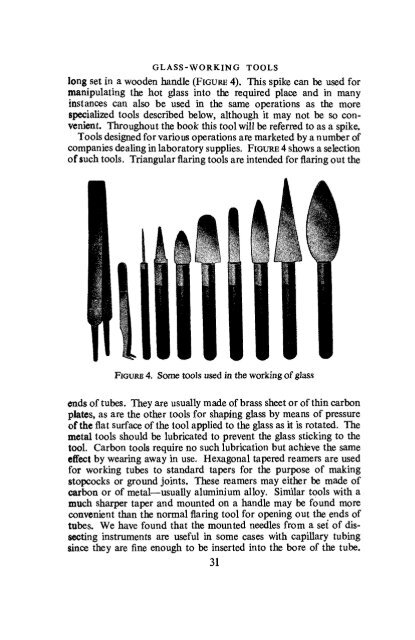Laboratory Glass-Working for Scientists - Sciencemadness Dot Org
Laboratory Glass-Working for Scientists - Sciencemadness Dot Org
Laboratory Glass-Working for Scientists - Sciencemadness Dot Org
You also want an ePaper? Increase the reach of your titles
YUMPU automatically turns print PDFs into web optimized ePapers that Google loves.
GLASS-WORKING TOOLS<br />
long set in a wooden handle (FIGURE 4). This spike can be used <strong>for</strong><br />
manipulating the hot glass into the required place and in many<br />
instances can also be used in the same operations as the more<br />
specialized tools described below, although it may not be so convenient.<br />
Throughout the book this tool will be referred to as a spike.<br />
Tools designed <strong>for</strong> various operations are marketed by a number of<br />
companies dealing in laboratory supplies. FIGURE 4 shows a selection<br />
of such tools. Triangular flaring tools are intended <strong>for</strong> flaring out the<br />
FIGURE 4. Some tools used in the working of glass<br />
ends of tubes. They are usually made of brass sheet or of thin carbon<br />
plates, as are the other tools <strong>for</strong> shaping glass by means of pressure<br />
of the flat surface of the tool applied to the glass as it is rotated. The<br />
metal tools should be lubricated to prevent the glass sticking to the<br />
tool. Carbon tools require no such lubrication but achieve the same<br />
effect by wearing away in use. Hexagonal tapered reamers are used<br />
<strong>for</strong> working tubes to standard tapers <strong>for</strong> the purpose of making<br />
stopcocks or ground joints. These reamers may either be made of<br />
carbon or of metal—usually aluminium alloy. Similar tools with a<br />
much sharper taper and mounted on a handle may be found more<br />
convenient than the normal flaring tool <strong>for</strong> opening out the ends of<br />
tubes. We have found that the mounted needles from a set of dissecting<br />
instruments are useful in some cases with capillary tubing<br />
since they are fine enough to be inserted into the bore of the tube.<br />
31<br />
• ^ < Wvi
















